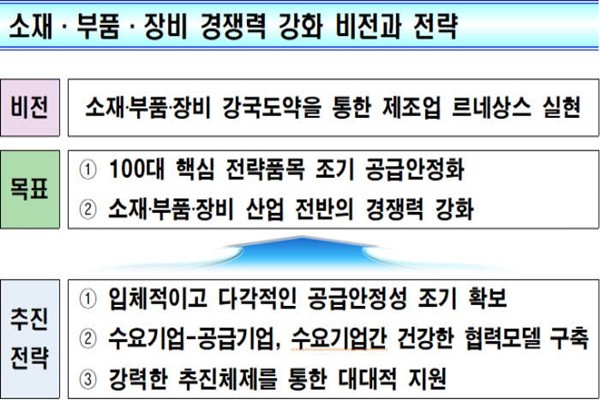South Korean Government’s measure to strengthen competitive edge of domestic materials, parts, and equipment includes various measures to strengthen fundamental competitive edge of relevant industries centered on 100 items that are highly dependent on Japanese businesses. South Korean Government has created a detailed measure by supplementing flaws of current policies on materials, parts, and equipment so that key technologies can be used in actual manufacturing scenes.
This measure had 11 departments such as Ministry of Trade, Industry and Energy (MOTIE), Ministry of Economy and Finance (MOEF), Ministry of Science and ICT (MSIT), and Ministry of SMEs and Startups (MSS) and it is based on every possible support. South Korean Government’s intent is to push for long-term political support to create a foundation that will allow industries of materials, parts, and equipment become independent.
◊South Korean Government selects 100 key items
First, South Korean Government selected 100 key items from six fields such as semiconductor, display, automotive, electronic, machinery and metal, and basic chemistry after going through opinions from relevant industries and examinations by experts. Depending on level of urgency, these 100 items are further divided into short-term items (1 year, 20 items) and medium to long-term items (5 years, 80 items).
To have strong private investments, South Korean Government is going to look to resolve difficulties regarding investments into materials, parts, and equipment related to future vehicle, semiconductor, and others. Pension funds, fund of funds, and private equity funds are going to participate and create a large-scale fund that will invest into materials, parts, and equipment. South Korean Government is going to expand contract-based department for small and medium businesses and supply specialized professionals.
‘Materials, Parts, Equipment Competitive Edge Committee’ is going to support collaborative model between businesses. Although there are domestic technologies, the committee has come up with a measure while thinking about how technologies have died out.
“It is not easy to connect R&D to actual production with current policies due to different interests between buyers and suppliers.” said Minister Sung Yoon-mo of MOTIE. “We have strengthened collaborative system of an area where R&D jumps to actual production.”

◊South Korean Government to push for exemption of preliminary feasibility test on few major tasks
South Korean Government is also pushing for exemption of preliminary feasibility test on few major tasks. Preliminary feasibility test is a system set up to evaluate validity of R&D and it has drawn criticisms due to its long evaluation period and strict evaluations.
‘Material Industry Innovative Technology Development Project’ worth $4.13 billion (5.0129 trillion KRW) and ‘Manufacturing Equipment System Development Project’ worth $659 million (800 billion KRW) are currently going through preliminary feasibility tests. South Korean Government is looking to provide an exemption on preliminary feasibility test for major projects and enforce its decision in 2020. It is expected that projects involving machinery and carbon fiber, which are likely to be regulated by Japanese Government in the future, will also be given exemptions on preliminary feasibility test as well.
South Korean Government is planning to have the committee oversee fund, position, tax system, and regulatory exemption to have relevant industries become independent.
MSS is going to establish ‘Small, Medium, and Large Businesses Coexistence Committee’ so that large corporations will continue to purchase goods from small and medium businesses. The committee will have large corporations and small and medium businesses from six major industries participating and it will operate various programs such as item selection, joint R&D, and verification test. It is also going to support 100 small giants within the industries of materials, parts, and equipment and start ‘Material, Part, Equipment 100 + 100 Project’ that will select and promote 100 key startup companies.
“The most important task for us to do right now is to maintain relationship between small and medium businesses and major corporations and healthy ecosystem.” said Minister Park Young-seon of MSS with emphasis.
◊Quality and quantity of national R&D to face changes
National R&D will face huge changes quantitatively and qualitatively. South Korean Government is going to drastically increase amount of budget so that fundamental technologies that rely heavily on foreign countries such as Japan can stand on their own and strengthen strategies.
“Although it would have been nice if R&D budget focuses on strategies, it is spread out.” said Minister Yoo Young-min of MSIT.
Amount of R&D budget related to materials and parts has been around 4& of entire R&D budget. In 2017, the amount was $584 million (708.9 billion KRW). Although this is not a small amount, many point out that there were not visible results in order to secure fundamental technologies that can become a ‘vital spot’ of South Korean industries.
To improve competitive edge of materials and parts industries, South Korean Government is planning to invest $6.42 billion (7.8 trillion KRW) into related R&D for the next seven years. There is a high chance that next year’s R&D budget will increase by more than $824 million (1 trillion KRW). South Korean Government is planning to present ways for strategic investment to secure fundamental technologies in materials and parts for the direction of national investments on R&D in 2021. While strengthening research on basic and fundamental technologies, it is also planning to spend its budget into application and commercialization of technologies that are already developed.
Staff Reporter Byun, Sanggeun | sgbyun@etnews.com & Staff Reporter Kim, Myunghee | noprint@etnews.com & Staff Reporter Choi, Ho | snoop@etnews.com